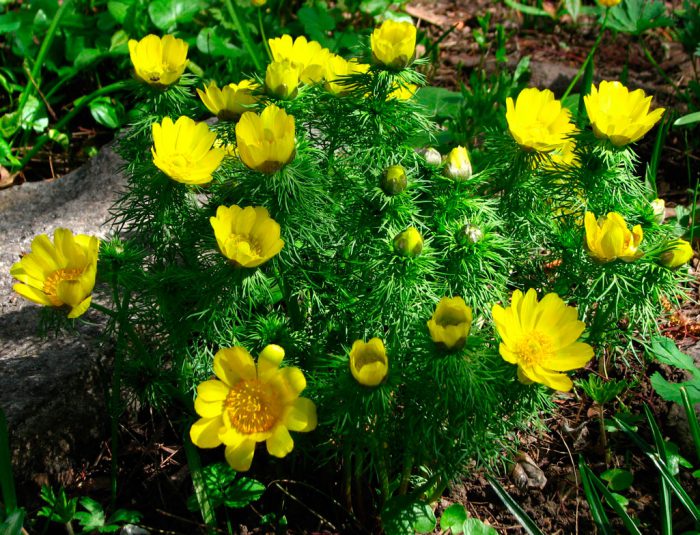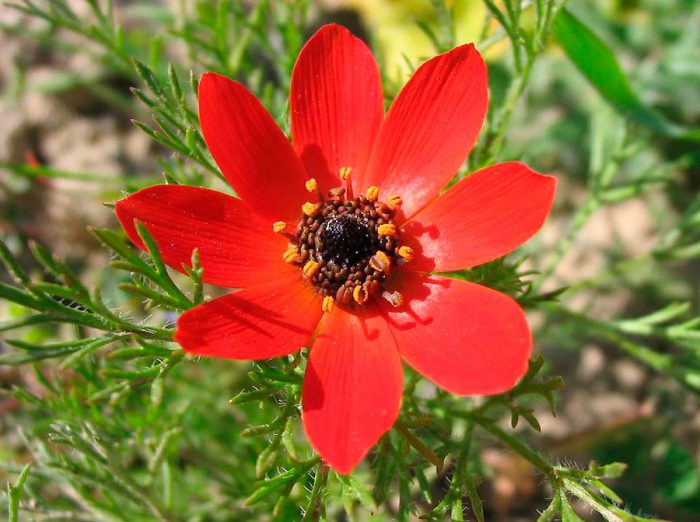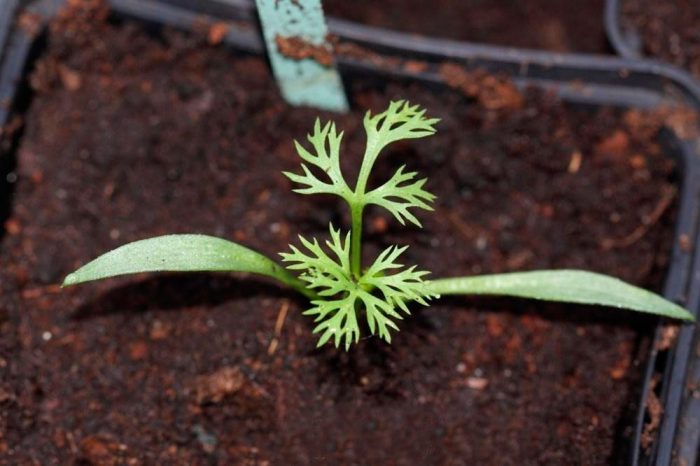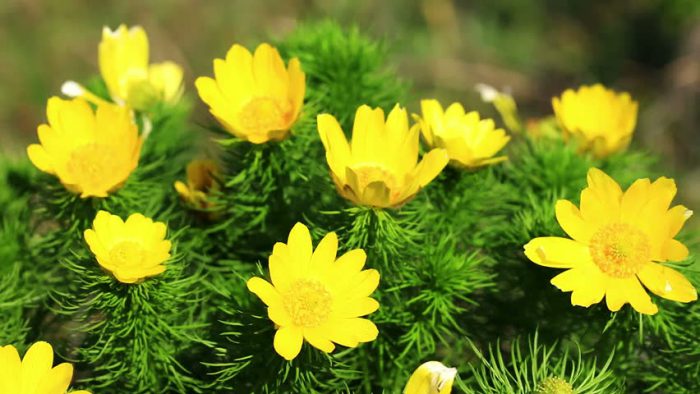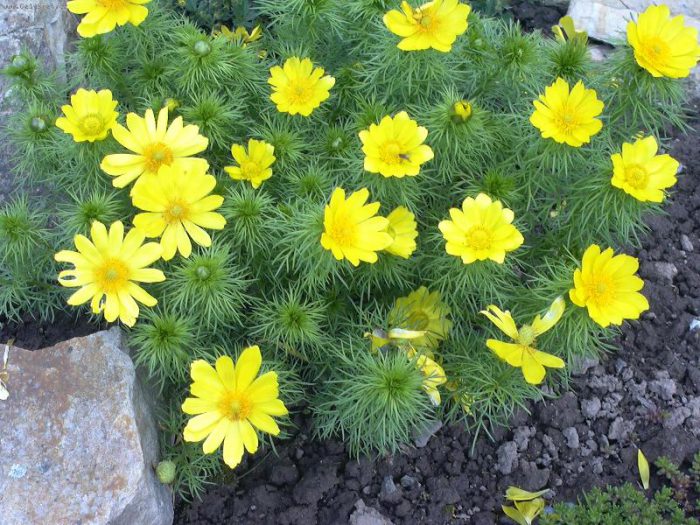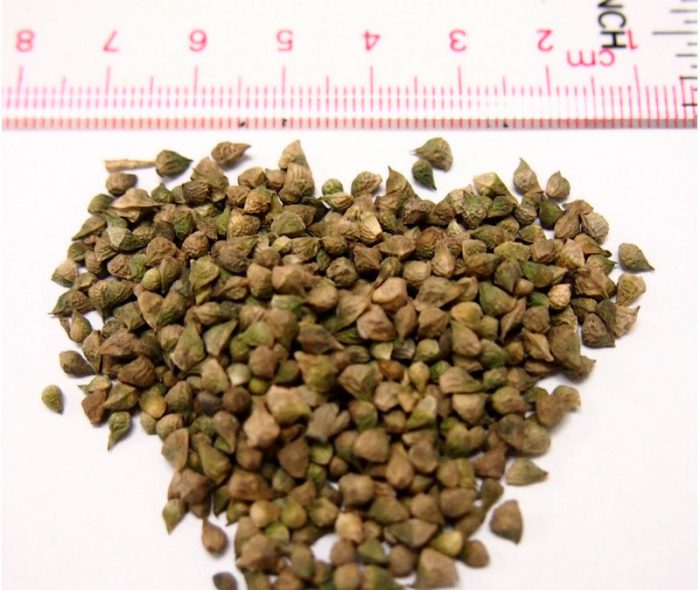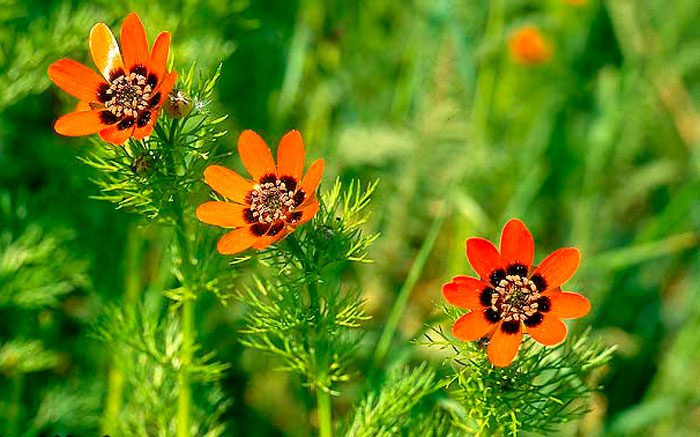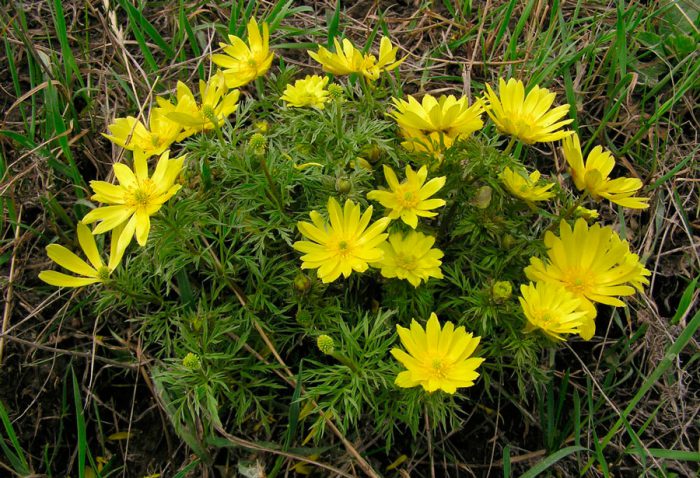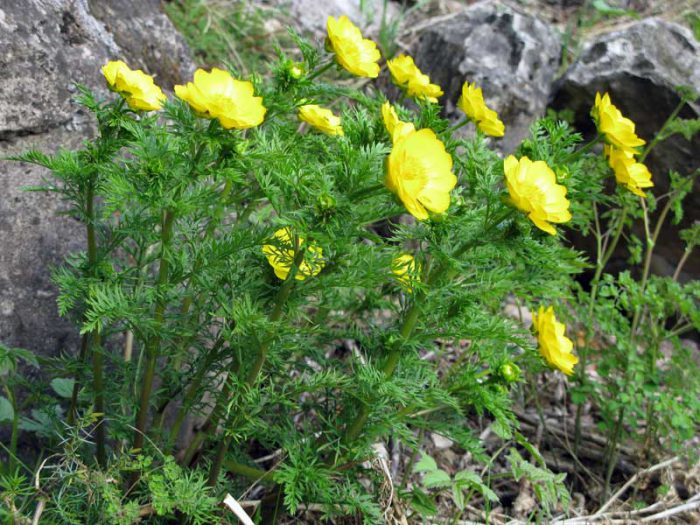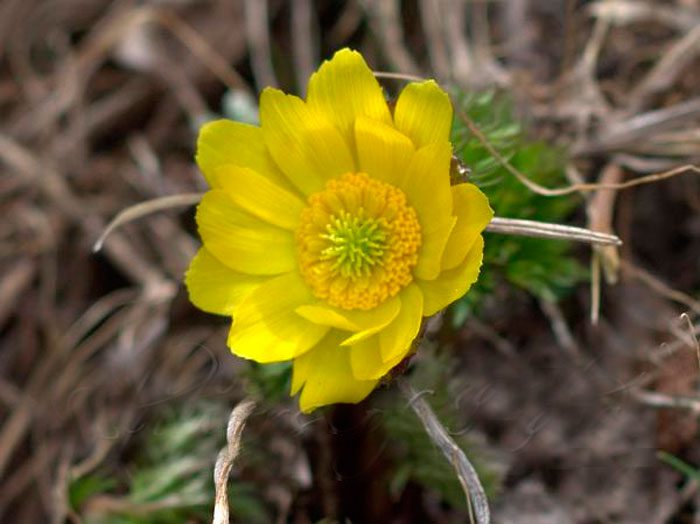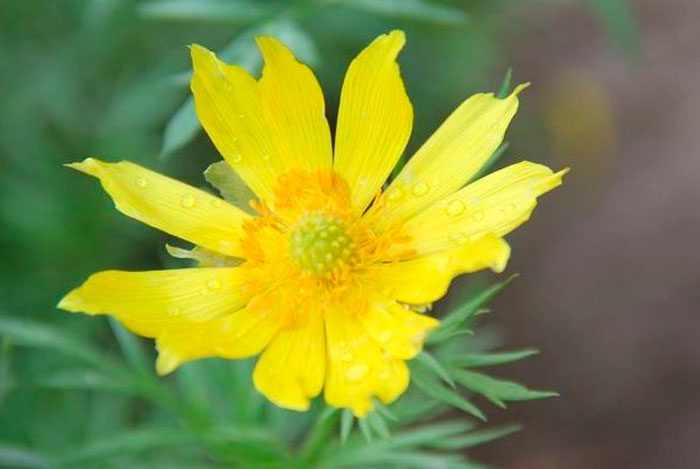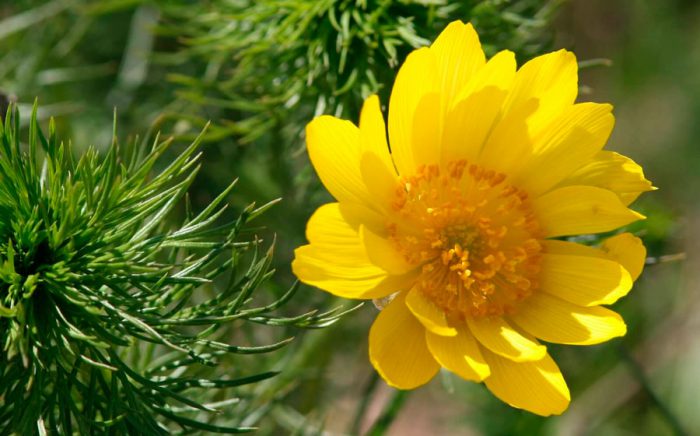A plant such as Adonis (Adonis) is directly related to the genus of the buttercup family. According to various sources, this genus unites 20–45 species of different plants, which are represented by herbaceous perennials, as well as annuals. In natural conditions, they can be found in the temperate regions of Asia, as well as in Europe. Such a plant reacts negatively to heat. Adonis is a Latin name. So, this flower was named in honor of the son of the Cypriot king, according to myths. Aphrodite fell in love with Adonis, but he died while hunting. The blood of the deceased young man colored all the flowers in a bright red color. In this regard, most likely this myth applies only to adonis, painted in red, but there are relatively few of them. But there is also another version. So, this plant was named after the Assyrian god Adon. Adonis became very popular with gardeners only at the end of the 17th century. Since that time, such a flower can be found quite often both in gardens, flower beds, and in parks.
Content
Features of adonis
The shoots of such a flower are branched or simple. Foliage is repeatedly finger-like or pinnately dissected into narrow lobes. Lonely flowers are shiny and painted in rich yellow, less often red. Their diameter ranges from 4 to 6 centimeters, and they have 10–20 petals. They are located at the ends of the stems. The fruits are presented in leaflets, which contain shriveled seeds, their nose can be straight or bent. It should be remembered that any part of the plant contains toxic substances.
Growing adonis from seeds
Sowing
Seeds retain good germination for a relatively short time. In this regard, sow in open ground, freshly harvested seeds are recommended. Sowing should be done in November before winter, while they need to be buried by 1–2 centimeters. But this applies only to those species that are annuals. If the seeds are collected from flowers that are 6-7 years old or more, then their germination will be higher. In order for them to germinate, a temperature of plus 5 degrees is required. If you purchased the seeds from a store, then they must be sown in a greenhouse in early spring. For sowing, it is recommended to use a soil mixture consisting of sand (2 or 3 parts), sod land (1 part) and humus (1 part). The first seedlings can be seen after 14–20 days.Sowing of seeds of perennial species is carried out in autumn and for this they use boxes that must be filled with the same soil mixture. Then the box is removed to a cool place, and when it snows, it is placed under a snowdrift. The first seedlings will appear in spring after the air warms up to 20 degrees. However, there are seeds that sprout only after 12 months.
How to care for seedlings
Seedlings need bright lighting, but it must necessarily be diffused. Seedlings should be protected from direct sunlight. The plant also needs to be watered every day and gently loosened the surface of the substrate. The grown seedlings are thinned out if necessary. So, between them there should be a distance of 15–20 centimeters. However, if it is already April, then thinning can be omitted, because soon the plants will need to be planted in open soil. The fact is that a transplant for Adonis is a lot of stress.
Transplanting seedlings into open ground
When to plant?
Grown and mature plants should be planted in open soil. So, this time can fall on April-May or August-September - it directly depends on when exactly the seeds sprouted. However, you should know that for successful wintering, plants need to root well, and this will take about 4 weeks. Adonis can be grown in a sunny or slightly shaded area. So, the plant feels best in such an area where the sun is shining in the morning, and at lunchtime it is in the shade. In the event that you want the flowering to be abundant, then the plants should be planted in drained light soil, which contains a lot of organic matter and lime. It is best if the pH is 7.0-7.5.
Disembarkation
A distance of 25-30 centimeters must be kept between plants. The depth of the planting hole depends on the size of the plant root. So, it should be done in such a way that the root placed in it remains even, and is not bent. The planted plants must be watered, and the surface of the soil should be sprinkled with a layer of mulch (peat). But it should be remembered that the plant will definitely not bloom this year. Adonis belongs to slow-growing plants, while a flower of four or five years of age is considered a well-developed plant.
Caring for adonis in the garden
Growing
In order to grow a healthy plant, it must be watered often enough. In this case, the frequency of watering does not depend on the rate of drying of the soil surface. The resulting crust on the soil surface must be removed by loosening. Plants must be systematically spud, as a result of the renewal buds must be covered with earth, and they are placed at the base of the stem. Adonis also needs to be fed with full complex fertilizer, but this is done only if necessary. As a rule, fertilizing is done before flowering begins, as well as at the end of summer. For the first 2 years, experts do not advise cutting the flowers that have appeared, since it is at this time that renewal buds begin to form, and they cannot be injured in any case.
Reproduction of adonis
Adonis can be propagated by the seed method (described above), as well as by dividing the bush. Only bushes of four or five years of age are suitable for division. If there is no need to divide the bush, then the transplant should be done once a decade. Grow such plants on the same plant for two decades. You can divide the bush in August or in the first days of September. However, this can be done in spring, but only before the beginning of the period of active growth. The bush is carefully dug out, a very sharp knife is taken, and the root is cut into the required number of parts. Roots and kidneys should be present on each section. Places of cuts should be smeared with a disinfectant, then they are planted in a permanent place. Since these are slow-growing plants, it is recommended to make the cut as large as possible. The fact is that small dealerships get very sick and may eventually die. It is necessary to take care of the divided flowers in the same way as for young specimens.In the same year, flowers will appear on the bushes, but they will be very small. It is recommended to remove them so that the bush does not waste its energy on them.
Diseases and pests
Such a flower is very poisonous, so harmful insects, like pathogens of various diseases, bypass it.
Adonis after flowering
Seed collection
Seeds are collected after they begin to fall, but it is best to collect them a little unripe. It makes no sense to put them in storage. In this regard, it is recommended to mix them with moistened sand and sow in open soil.
Preparation for wintering
Such a plant is winter-hardy and does not need shelter. But this does not apply to planted seedlings or to cuttings planted in the fall. They must be covered with peat, and spruce branches must be placed on top. After a year, they will be already strong enough and will be able to survive the winter normally without shelter.
The main types and varieties with photos and names
The types of such plants are divided into annuals and perennials.
Annuals
Summer Adonis (Adonis aestivalis)
Or "coal on fire" - it can be found in Western Europe, Central Asia, as well as in the south of the European part of Russia. The British call this type "pheasant eyes". His shoots are branched, straight or simple. They are furrowed, glabrous and reach a height of 10 to 50 centimeters. The leaf plates on the top are sessile, those on the bottom are petiolar. They are twice or thrice dissected into narrow lobes. The diameter of single flowers is from 2 to 3 centimeters. The perianth consists of flat red leaves, which have a dark spot in the central part. Bloom is observed from June to August.
Autumn Adonis (Adonis annua)
Or one-year-old adonis (Adonis automnalis) - in natural conditions it can be found in the Mediterranean. The bush reaches a height of about 30 centimeters. There are thin alternate dissected leaves. Spectacular flowers are painted in light yellow or deep red, while the central part is dark in color. Their diameter is about one and a half centimeters, while their petals are closed at the top. Flowering is also observed from June to August. Cultivated since 1596
Perennials
Adonis volzhsky (Adonis volgensis)
Its light brown rhizome is rather thick and short. Shoots are relatively few and they reach a height of about 30 centimeters. Their branching begins in the middle. Young shoots and foliage are densely pubescent, but when the flower fades for the first time, the pubescence becomes more rare. The leaf plates are finger-dissected into lanceolate-linear lobes, which curl down at the edges. The color of the flowers is light yellow, while the sepals, on the surface of which there is pubescence, have a lilac color.
Amur Adonis (Adonis amurensis)
It occurs naturally in the Far East, which is the homeland of this species. It can also be found in the northeastern part of China, in Japan, and also on the Korean Peninsula. During flowering, the bush reaches a height of about 12 centimeters. Such a forest look has pinnately dissected leaves with petioles. Flowering lasts about 20 days. Flowers grow earlier than leaf plates. They are wide open and reach 5 centimeters in diameter, and are painted in a yellowish-golden color. After the leaves appear, the bush reaches a height of 35 centimeters. This species has been cultivated for a long time, Japanese breeders have created many of its varieties, among which there are terry varieties:
- Benten - fringed flowers are painted white;
- Sandanzaki - in the center of semi-double yellow flowers are green petals;
- Hinomoto - the inner part of the flowers is orange-red, and the outer part is green-bronze;
- Pleniflora - terry flowers of a greenish-yellow color;
- Ramosa - double flowers of brownish-red color.
Siberian Adonis (Adonis sibirica)
Or Adonis apennina - in nature you can meet in the east of the European part of Russia, in Mongolia, in Western and Eastern Siberia.The height of the bush is about 60 centimeters, the leaf plates are pinnately divided. The rich yellow flowers reach 6 centimeters in diameter. Flowering begins in May or June.
Fluffy Adonis (Adonis villosa)
Under natural conditions, it can be found in Kazakhstan and Siberia, while this species prefers to grow on the edges of birch groves and on flat steppes. The short rhizome has a brown color. Shoots are solitary, at the beginning of flowering they are densely pubescent, reaching a height of about 15 centimeters. After the plant has faded, double-pinnate leaves of a wide-triangular or oval shape grow, and the stems become less pubescent and lengthen up to 30 centimeters. The color of the flowers is light yellow.
Adonis golden (Adonis chrysocyathus)
Such a plant in Central Asia is considered one of the rarest. This medicinal and decorative flower, which is highly valued, can be found in Western Tibet and Kashmir, as well as in the Tien Shan. This species is included in the international Red Book.
Adonis Turkestan (Adonis turkestanicus)
It is endemic to the Pamir-Alai. This plant is also medicinal. On parts of the plant that are located above the ground, there are curly hairs. The diameter of single flowers is from 4 to 6 centimeters. The inner surface of the petals is colored orange-yellow, and the outer surface is light blue. On such a bush, buds, ovaries and flowers can be present at the same time.
Adonis Mongolian (Adonis mongolica)
It is endemic to Mongolia, prefers to grow on abandoned pastures. One bush can have about 30 stems, while there are second and third order. The basal leaves are reduced, and the median ones are sessile. The diameter of the flowers is about 5 centimeters. Pale green sepals have a purple tint and short pubescence. The color of the petals is white. After blooming, the leaf plates open.
Spring Adonis (Adonis vernalis)
The flower is decorative and medicinal, cultivated since the 16th century. In nature, it can be found in the steppes of Eastern and Central Europe, in North-Eastern Kazakhstan, in the Ciscaucasia, in Western Siberia, as well as in the Crimea. The multi-headed rhizome is short and thick. There are a large number of branched, ribbed shoots. At the beginning of flowering, the height of the shoots is from 5 to 20 centimeters, and then they stretch to 40-60 centimeters. Below, on the surface of the shoots, there are brown scales, in their axils, the development of renewal buds occurs. Foliage is palmate-divided with narrow lobes. The diameter of the yellow flowers is about 7 centimeters, they have from 12 to 20 glossy petals. Flowering begins from 4-6 years of life in the last days of April or the first - in May and lasts half a month.
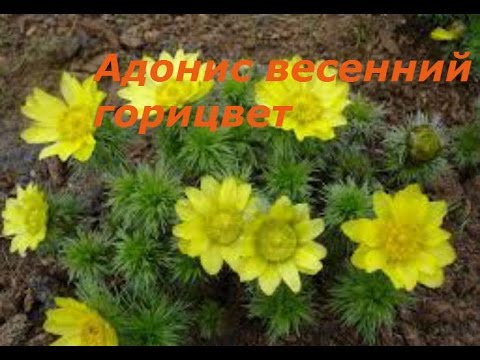

Watch this video on YouTube

